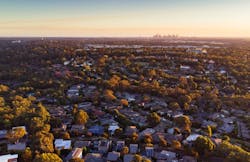Single-family home building in suburbs slowed from 18.7% in the first quarter of 2021 to 5.2% in the first quarter of 2022 as a result of supply chain disruptions and record high costs for building materials, NAHB Eye on Housing reports. While demand for suburban homes soared during the pandemic as city-goers switched to remote work and relocated for space and affordability, homebuyer preferences for suburbs appeared to ease at the start of 2022.
Large metro suburban counties saw the greatest slowdown in residential construction, and large metro core counties also experienced a gradual decline, but micro counties posted a 3.9% increase from the first quarter of 2021 to 16.7% in 2022.
Market share changes also reflected the slowdown of large metro suburban counties’ single-family construction. On a four-quarter moving average, year-over year basis, large metro suburban counties’ single-family construction’s market share dropped from the first quarter of 2021 by 1.3 percentage points to 24.8%. Large metro core counties’ market share dropped by 0.3 percentage points to 16.6%. All other regions, which can be grouped as “lower-density submarkets”, captured the above market share decreases. Large metro areas’ outlying counties’ market share increased the most, by 0.5 percentage points to 9.6% and non-metro, non-micro counties increased the least, by 0.1 percentage points to 4.2%.
